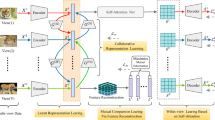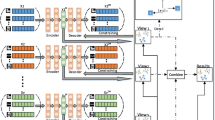Abstract
In the last decade, deep learning has made remarkable progress on multi-view clustering (MvC), with existing literature adopting a broad target to guide the network learning process, such as minimizing the reconstruction loss. However, despite this strategy being effective, it lacks efficiency. Hence, in this paper, we proposed a novel framework, entitled Efficient Multi-view Clustering Networks (EMC-Nets), which guarantees the network’s learning efficiency and produces a common discriminative representation from multiple sources. Specifically, we developed an alternating process, involving an approximation and an instruction process, which effectively stimulate the process of multi-view feature fusion to force network to learn a discriminative common representation. The approximation process employs a standard clustering algorithm, i.e., k-means, to generate pseudo labels corresponding to the current common representation, and then it leverages the pseudo labels to force the network to approximate a reasonable cluster distribution. Considering the instruction process, it aims to provide a correct learning direction for the approximation process and prevent the network from obtaining trivial solutions. Experiment results on four real-world datasets demonstrate that the proposed method outperforms state-of-the-art methods. Our source code will be available soon at https://github.com/Guanzhou-Ke/EMC-Nets.







Similar content being viewed by others
References
Lowe DG (2004) Distinctive image features from scale-invariant keypoints. International Journal of Computer Vision 60(2):91–110
Dalal N, Triggs B (2005) Histograms of oriented gradients for human detection. CVPR 1:886–893
Ojala T, Pietikainen M, Maenpaa T (2002) Multiresolution gray-scale and rotation invariant texture classification with local binary patterns. IEEE TPAMI 24(7):971–987
Yang Y, Wang H (2018) Multi-view clustering: A survey. Big Data Mining and Analytics 1(2):83–107
Liu J et al (2013) Multi-view clustering via joint nonnegative matrix factorization, In: Proceedings of the 2013 SIAM international conference on data mining, society for industrial and applied mathematics
Zhang Z et al (2018) Binary multi-view clustering. IEEE Transactions on Pattern Analysis and Machine Intelligence 41(7):1774–1782
Peng X, Huang Z, Lv J, Zhu H, Zhou JT (2019) COMIC: Multi-view clustering without parameter selection. International Conference on Machine Learning 97(ICML’19):5092–5101
Chaudhuri K et al (2009) Multi-view clustering via canonical correlation analysis. In: Proceedings of the 26th annual international conference on machine learning, ACM, pp 129–136
Melzer T, Reiter M, Bischof H (2001) Nonlinear feature extraction using generalized canonical correlation analysis. In: Proc. intern. conf. artificial neural networks (ICANN2001), pp 353–360
Galen A, Raman A, Jeff B, Livescu K (2013) Deep canonical correlation analysis. In: International conference on machine learning, pp 1247–1255
Zhao H, Zhengming D, Yun F (2017) Multi-view clustering via deep matrix factorization. In: Proceedings of the AAAI conference on artificial intelligence, vol 31, No 1
Abavisani M, Patel VM (2018) Deep multimodal subspace clustering networks. IEEE Journal ofSelected Topics in Signal Processing 12(6):1601–1614
Zhang C, Liu Y, Fu H (2019) AE\(^2\)-Nets: Autoencoder in autoencoder networks. In: Proceedings of the IEEE/CVF conference on computer vision and pattern recognition, pp 2577–2585
Zhang Y et al (2019) A multitask multiview clustering algorithm in heterogeneous situations based on LLE and LE. Knowledge-Based Systems 163:776–786
Zhaoyang L, Wang Q, Tao Z, Gao Q, Yang Z (2019) Deep Adversarial multi-view clustering network. In: IJCAI, pp 2952–2958
Zhou R, Shen Y-D(2020) End-to-End adversarial-attention network for multi-modal clustering. In: Proceedings of the IEEE/CVF conference on computer vision and pattern recognition, pp 14619–14628
Goodfellow IJ et al (2014) Generative adversarial nets. In: Proceedings of the 27th international conference on neural information processing systems - volume 2 (NIPS’14). MIT Press, Cambridge, MA, USA, pp 2672–2680
Zhan X, Xie J, Liu Z, Ong Y-S, Loy CC (2020) Online deep clustering for unsupervised representation learning. In: Proceedings of the IEEE/CVF conference on computer vision and pattern recognition, pp 6688–6697
Caron M, Piotr B, Joulin A, Douze M (2018) Deep clustering for unsupervised learning of visual features. In: Proceedings of the european conference on computer vision (ECCV), pp 132–149
Vaswani A et al (2017) Attention is all you need. In: NIPS
Jing L, Tian Y (2020) Self-supervised visual feature learning with deep neural networks: A survey. IEEE Transactions on Pattern Analysis and Machine Intelligence
Tu W et al (2021) Deep fusion clustering network. In: AAAI
Xu LL, Neufeld J, Larson B, Schuurmans D (2005) Maximum margin clustering. In: Proc. 18th annu. conf. advances in neural information processing systems 17, Cambridge, MA, USA, pp 1537–1544
Du L, Zhou P, Shi L, Wang HM, Fan MY, Wang WJ, Shen YD (2015) Robust multiple kernel k-means using ’2;1-norm. In: Proc. 24th int. conf. artificial intelligence, Buenos Aires, Argentina, pp 3476–3482
Chaudhuri K, Kakade SM, Livescu K, Sridharan K (2009) Multi-view clustering via canonical correlation analysis. In: Proc. 26th annu. int. conf. machine learning, Montreal, Canada, pp 129–136
Zhao XR, Evans N, Dugelay JL (2014) A subspace co-training framework for multi-view clustering. Pattern Recogn. Lett. 41:73–82
Guo YH (2013) Convex subspace representation learning from multi-view data. In: Proc. 27th AAAI conf. artificial intelligence, Bellevue, WA, USA, pp 387–393
Xue Z, Li GR, Wang SH, Zhang CJ, Zhang WG, Huang QM (2015) (2015) GOMES: A group-aware multi-view fusion approach towards real-world image clustering. In: Proc. IEEE int. conf. multimedia and expo, Turin, Italy, pp 1–6
Wang W et al (2015) On deep multi-view representation learning. In: International conference on machine learning, PMLR, pp 1083–1092
Bottou L (2012) Stochastic gradient descent tricks. In: Neural networks: Tricks of the trade, Springer, pp 421–436
Hinton GE, Salakhutdinov RR (2006) Reducing the dimensionality of data with neural networks. Science 313(5786):504–507
Asuncion A, Newman D (2007) Uci machine learning repository
Shang C, Palmer A, Sun J, Chen K-S, Lu J, Bi J (2017) VIGAN: missing view imputation with generative adversarial networks. arxiv:1708.06724
Cai X, Wang H, Huang H, Ding C (2012) Joint stage recognition and anatomical annotation of drosophila gene expression patterns. Bioinformatics 28(12):i16–i24
Jiang Y-G, Ye G, Chang S-F, Ellis D, Loui AC (2011) Consumer video understanding: A benchmark database and an evaluation of human and machine performance. In: ICMR, pp 29
Kumar A, Rai P, Daume H (2011) Co-regularized multi-view spectral clustering. In: NIPS, pp 1413–1421
Ng AY, Jordan MI, Weiss Y (2001) On spectral clustering: Analysis and an algorithm. In: Proceedings of the 14th international conference on neural information processing systems: natural and synthetic
Cai X, Nie F, Huang H (2013) Multi-view k-means clustering on big data. In: Twenty-Third international Joint conference on artificial intelligence
Xia R, Pan Y, Du L, Yin J (2014) Robust multi-view spectral clustering via low-rank and sparse decomposition. In: AAAI, pp 2149–2155
Zhan K, Nie F, Wang J, Yang Y (2019) Multiview consensus graph clustering. In: A publication of the IEEE signal processing society, IEEE transactions on image processing
Nie F, Li J, Li X et al (2016) Parameter-free auto-weighted multiple graph learning: A framework for multiview clustering and semi-supervised classification. In: IJCAI, pp 1881–1887
Glorot X, Bordes A, Bengio Y (2011) Deep sparse rectifier neural networks. In: Proceedings of the fourteenth international conference on artificial intelligence and statistics, JMLR Workshop and Conference Proceedings, pp 315–323
Glorot X, Bengio Y (2010) Understanding the difficulty of training deep feedforward neural networks. In: Proceedings of the thirteenth international conference on artificial intelligence and statistics, JMLR workshop and conference proceedings, pp 249–256
Hinton GE, Nitish S, Krizhevsky A, Sutskever I, Salakhutdinov RR (2012) Improving neural networks by preventing co-adaptation of feature detectors. arXiv:1207.0580
Ketchen DJ, Shook CL (1996) The application of cluster analysis in strategic management research: an analysis and critique. Strategic Management Journal 17(6):441–458
van der Maaten L, Hinton G (2008) Visualizing data using t-SNE. Journal of Machine Learning Research 9:2579–2605
Dempster AP, Laird NM, Rubin DB (1977) Maximum likelihood from incomplete data via the EM algorithm. Journal of the Royal Statistical Society: Series B (Methodological) 39(1):1–22
Kuhn HW (1955) The Hungarian method for the assignment problem. Naval research logistics quarterly 2(1–2):83–97
Acknowledgements
This work was supported by Natural Science Foundation of Guangdong Province, China (No. 2020A1515011468; 2016A0303010003); Guangdong University Scientific Research Project, China (No. 2019KTSCX189; 2018KTSCX235; 2018WZDXM014); Joint Research and Development Fund of Wuyi University and Hong Kong and Macau (2019WGALH21).
Author information
Authors and Affiliations
Corresponding author
Additional information
Publisher's note
Springer Nature remains neutral with regard to jurisdictional claims in published maps and institutional affiliations.
Appendix: Network architectures
Appendix: Network architectures
In this section, we report the details of the network architecture, includes network layer, input and output size, hyper-parameters of the layer, and the total number of parameters, used in the experiments. Note that all the layer of network are used Pytorch-style API. For the fully-connected (linear) layer, we use bias as default, and we report the head and the dimension of feedforward (dff) of the TransformerEncoder (Tables 7, 8, 9, 10).
Rights and permissions
About this article
Cite this article
Ke, G., Hong, Z., Yu, W. et al. Efficient multi-view clustering networks. Appl Intell 52, 14918–14934 (2022). https://doi.org/10.1007/s10489-021-03129-0
Accepted:
Published:
Issue Date:
DOI: https://doi.org/10.1007/s10489-021-03129-0




